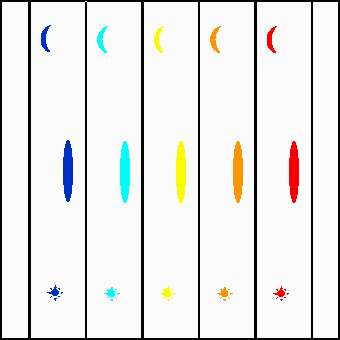CFHT, Instruments, Spectroscopy, GriF, Instrument Description.
GriF Description
Four different modes are offered with the GriF instrument depending on
which of the subcomponents are inserted in the beam.
Overview of the system

The three components of GriF are:
The Fabry-Perot Interferoemter
The Fabry Perot offers a spectral resolution of approximately 2000. It
is transmissive in H and K, so if used in stand-alone mode (with a
narrow band filter), it can be used as a very narrow band filter or to
scan emission lines as demonstrated on this picture of
OMC-1, obtained in the H2 v=1-0 s(1) line. The unvignetted field of
view is then 36" x 36".
The focal plane mask
The focal plane mask contains 9 positions, currently with the following
masks:
- An open position, to be used without GriF or with Fabry Perot
alone,
- three slits with widths of 0.1, 0.25" and 0.5" for long slit
spectroscopy,
- two rectangular slits (5"x36" and 3.5"x36") to be used in cross
dispersed mode ("GriF mode"),
- and two coronographic masks, 1.1" and 0.8" in diameter.
- The last position is under consideration for another coronogrpahic
mask.
This picture shows the focal
plane wheel inside of KIR, with the different positions.
Note: A new mask should be cut soon, so watch for an update of this
page. Also, let us know if you
have special needs: masks are cut with the LAMA machine, and although it
is not a trivial operation, special shaped masks (e.g. a slit with an
occulting mask) can be cut if requested at least six weeks in advance.
The Grism cell
The grism cell assembly contains a collimating lens, an imaging lens, a
broad K band filter and the grism which allows for a R~400
resolution. It can be used with the long slit in place in the focal
plane wheel or with the Fabry Perot and the "GriF mode" masks.
Note that Cassegrain Bonnette rotation can be used to change the
orientation of the slit on the sky, and that slow differential tracking
can be implemented.
An example of a long slit exposure on NGC 1068 can be found in the First Images gallery
Possible modes and configurations
To summarize, these three elements can be configured for four general
modes:
- K-band long slit spectroscopy at R~400, using the grism and the
focal plane wheel
- coronography, using only the focal plane wheel
- H and K-band scanning Fabry-Perot imaging spectroscopy at
R~2000, using the Fabry Perot and a narrow band filter
- and cross-dispersed K-band Fabry-Perot imaging spectroscopy at
R~2000 ("GriF mode"), using the Fabry Perot, the focal plane wheel and
the grism. In this configuration, five different quasi monochromatic
images will present on the detector, corresponding to five transmitted
Fabry Perot orders (see illustration below).
"GriF observing mode" schematics

Olivier Lai
Last modified: Fri Feb 22 18:18:35 HST
